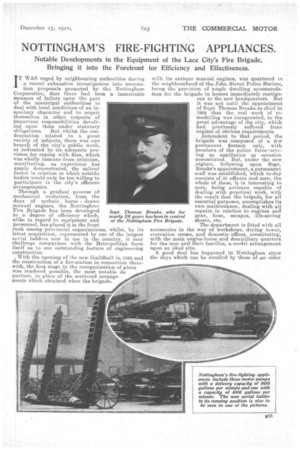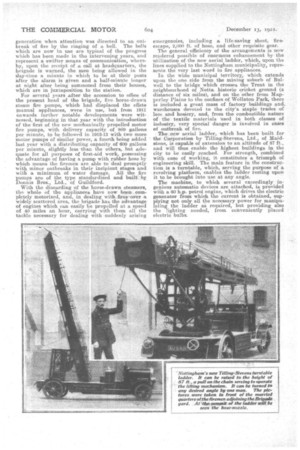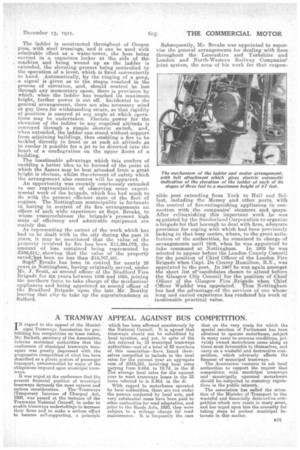NOTTINGHAM'S FIRE-FIGHTING APPLIANCES.
Page 11

Page 12

Page 13

If you've noticed an error in this article please click here to report it so we can fix it.
Notable Developments in the Equipment of the Lace City's Fire Brigade, Bringing it into the Forefront for Efficiency and Effectiveness.
IT WAS urged by neighbouring authorities during a recent exhaustive investigation into annexation proposals promoted by the Nottingham Corporation, that there had been a lamentable measure of failure upon the part of the municipal authorities to deal with local conditions of an insanitary character and to acquit themselves in other respects of important responsibilities devolving .upon them under statutory obligations. . But whilst the condemnation related to a great variety of subjects, there was one branch of the city's public work, as indicated by its adequate provision for coping with fires, which was wholly immune horn criticism, constituting. as experience has amply demonstrated, the salient factor in relation to which outside bodies would only be too willing to participate in the city's efficient arrangements.
Through a gradual -process of mechanical evolution, from the days of archaic horse drawn manual engines, the Nottingham Fire Brigade has been developed to a degree of efficiency which, alike in regard to equipment and personnel, has placed it in the front rank among provincial organizations, whilst, by its latest acquisition, represented by one of the largest aerial ladders now in use in the country, it may challenge comparison with the Metropolitan force itself as to one outstanding feature of engineering construction.
. With the opening of the new Guildhall in 1888 and the construction of a fire-station in connection therewith, the first stage in the reorganization of plans was rendered possible, the most notable de' parture, in place of the scattered arrangements which obtained when the brigade, with its antique manual engines, was quartered in the neighbourhood of the John Street Police Station, being the provision, of ample dwelling accommodation for the brigade in houses immediately contiguous to the new headquarters. But it was not until the appointment of Supt. Thomas Breaks as chief in 1902 that the real work of remodelling was inaugurated, to the great advantage of the city, which had Previously suffered from neglect of obvious requirements.
Antecedent to that period, the brigade was composed of a few permanent firemen only, with members of the police force4serving as auxiliaries as occasion necessitated. But, under the new regime, following upon Supt. Breaks's appointment, a permanent staff was established, which to-day consists of 31 officers and men, the whole of these, it is interesting to note, being artizans capable of dealing with practical work, with the result that the brigade, for all essential purposes, accomplishes its own maintenance, dealing wit'h all repairs in relation to engines and gear, hose, escapes, life-saving sheets, etc.
The department is fitted with all accessories in the way of workshops, drying tower, recreation rooms, and domestic offices, constituting, with the main engine-house and domiciliary quarters for the men and their families, a model arrangement upon an ideal site. A good deal has happened in Nottingham since the days which can be recalled by those of an older generation when attention was directed to an outbreak of fire by the ringing of a bell. The bells which are now in use are typical of the progress which has been made in tho intervening years, and represent a swifter means of communication, whereby, upon the receipt of a call at headquarters, the brigade is warned, the men being allowed in the day-time a minute in which to be at their posts after the alarm is given and a half-minute longer at night after being summoned from their houses, which are in juxtaposition to the station.
For several years .after the accession to office of the present head of the brigade, five horse-drawn steam fire pump, which had displaced the effete manual appliances, were in use, but from 1911 onwards further notable developments were witnessed, beginning in that year with the introduction of the first of the new mechanically propelled motor -fire pumps, with delivery capacity of 800 gallons per minute, to be followed in 1912-12 with two more motor pumps of similar power, a fourth being added last year with a distributing capacity of 600 gallons per minute, slightly lesa than the others, but adequate for all purposes of first-aid work, possessing the advantage of having a pump with rubber hose by which means the firemen are able to deal promptly with minor outbreaks in their incipient stages and with a minimum of water damage. All the fire pumps are of the type standardized and built by Dennis Bros., Ltd., of Guildford.
With the discarding of the horse-drawn steamers, thr whole of the appliances have now been completely motorized, and, in dealing with fires-aver a widely scattered area, the brigade has the advantage of engines which can easily be propelled at a speed of 40 miles an hour, carrying -with them all the tackle necessary for dealing with suddenly arising
emergencies, including a life-saving sheet, fireescape, 2,000 ft. of hose, and other requisite gear.
The general efficiency of the arrangements is now rendered possible of enormous enhancement by the utilization of the new aerial ladder, which, upon the lines supplied to the Nottingham municipality, represents the very last ward in fire appliances.
In the wide municipal territory„ which extends upon the one side from the mining suburb of Bulwell to the bridge which crosses the Trent in the neighbourhood of Notts. historic crieket ground (a distance of six miles), and on the other from Mapperley Plains to the confines of Wollaton Park, there is included a great mass of factory buildings and. warehouses devoted to the city's staple trades of lace and hosiery, and, from the combustible nature of the textile materials used in both classes of industry, very special danger is involved in cases of outbreak of fire.
The new aerial ladder, which has been built for the Corporation by Tilling-Stevens, Ltd., of Maidstone, is capable of extension to an altitude of 87 ft., and will thus enable the highest buildings in the city to be easily reached. For strength, combined with ease of working, it constitutes a triumph of engineering skill. The main feature in the construction is a turntable, which, serving the purpose of a revolving platform' enables the ladder resting upon it to be brought into use at any angle.
The machine, to which several exceedingly, ingenious automatic devices are attached, is provided with a 60 h.p. petrol engine, which drives the electric generator from which the current is obtained, supplying not only all the necessary power for manipulating the ladder as required, but providing also the lighting needed, from conveniently placed electric bulbs. The ladder is constructed throughout of Oregon pine, with steel trussings, and it can he used with admirable effect as a water-tower, the hose being carried in a capacious locker at the side of the
, machine and being wound up as the ladder is extended, the elevating process being controlled by the operation of a lever, which is fixed conveniently to hand. Automatically, by the ringing of a gong, a signal is given as to the stages reached_ in the process of elevation, ,and, should control be lost through any momentary cause, there is provision by which, when the ladder has reached its maximum height, further power is out off. Incidental to the general arrangement, there are also necessary wind or guy lines for withstanding strain, so that rigidity of position is assured at any angle at which operations may be undertaken. Electric power for the elevation of the ladder to any required altitude is conveyed through a simple 'electric switch, and, when extended, the ladder can stand without support from adjoining buildings, thus enabling a fire to be tackled directly in front or at such an altitude as to render it possible for a jet to he directed into the heart of a conflagration on the upper floors of a building.
The inestimable advantage which this confers of enabling a better idea to be formed of the point at which the flames may be best attacked from a great height is obvious, whilst theselement of safety which the arrangement also ensures will be apparent. An opportunity was recently courteously extended to our representative of observing some experimental work of the brigade, which has had much to do with the present efficient state of the fleet of engines. The Nottingham municipality is fortunate in having in control of its fire arrangements an officer of such wide experience as Supt. Breaks,. to whose resourcefulness the brigade's present high state of efficiency and admirable equipment are mainly due.
As representing the extent of the work which has had to be dealt with in the city during the. past 18 years, it may be mentioned that the value of the property involved by fire has been £11,294,072, the amount of loss • sustained being represented by £586,611showing that the 'value of the property saved:has been no less than £10,707,461. SuperBreaks has been in control for nearly 20 years in Nottingham, having originally served, under Mr. j. Scott, as second officer of the Bradford Fire Brigade for six years between 1889 and 1895, _joining the northern force to take charge of the mechanical appliances and being appointed' as second officer of the Bradford Brigade upon the late Mr. Bentley leaving that city to take up the superintendency at Safford.
Subsequently, Mr. Breaks was appointed to supervise the general arrangements for dealing with fires throughout the Lancashire and Yorkshire' and London and North-Western Railway Companies' joint system, the area of his work for that respon-.
sible post extending from York to Hull and Belfast, including the Mersey and other ports, with the control of fire-extinguishing appliances in connection with the companies' steamers and quays. After relinquishing this important work he was arpointed by the Sunderland Corporation to organize a brigade for that borough to deal with fires, adequate provision for coping with which had been previously lacking in that busy centre, where, to the great satisfaction of the authorities, he remained in charge of arrangements until 1902, when he was appointed to -take command at Nottingham. In 1903 he was selected to appear before the London Country Council for the position of Chief Officer of the London Fire Brigade when Capt. De Conroy Hamilton, R.N., was appointed to the post. In 1907 he was again amongst the short list of candidateschosen to attend before the Glasgow City Council for the position of Chief Officer of the Glasgow Fire 'Brigade when Chief Officer Waddel was appointed. Thus Nottingham has had the adv.antagesof the services of one whose long and varied experience has rendered his work of inestimable practical value.
































